Of the approximately twenty species of venomous snakes found in the United States, only six venomous snakes are found in Florida. Here is a helpful guide to identify those venomous snakes.
 EASTERN DIAMONDBACK RATTLESNAKE
EASTERN DIAMONDBACK RATTLESNAKE
Size: Usually 3–5 ft. (max. ~7 ft.)
Identification: Body color is tan, brown, or grayish; back is marked with a row of obvious dark diamonds outlined in cream. Distinct, dark bands, outlined in white, run from the corner of each eye to the corners of the jaw. Tail is tipped with a large rattle. Scales have obvious lengthwise ridges (keels). This venomous snake gives birth to live young (does not lay eggs).
Habitats: Found throughout Florida in flatwoods, sandhills, hammocks, and other dry forested habitats but generally avoids interiors of marshes and swamps. In urbanized areas, it may be found on golf courses and wooded lots.
Diet: Ground-dwelling birds, mice, rats, squirrels, gophers, small rabbit
 PYGMY RATTLESNAKE
PYGMY RATTLESNAKE
Size: Usually 1–1.5 ft. (max. ~2.5 ft.)
Identification: Relatively thick body is grayish; back and sides are marked with rows of dark gray-black, irregularly shaped blotches. Blotches on the back are especially dark and are often separated by a reddish-brown stripe down the spine. Obvious dark bands run from each eye to the corners of the jaw. Tail is tipped with a tiny rattle that is prone to breaking off. Scales have obvious lengthwise ridges (keels). This venomous snake gives birth to live young (does not lay eggs).
Habitats: Found throughout Florida in a wide variety of habitats from dry upland forests and sandhills to seasonally flooded flatwoods and marshes. It is the most commonly encountered venomous snake in urbanized areas, often in gardens or brush piles.
Diet: Insects, frogs, lizards, small snakes, nestling birds, mice
 TIMBER RATTLERS
TIMBER RATTLERS
Size: Usually 3.5–4.5 ft. (max ~6 ft.)
Identification: Thick body is pinkish-tan, yellowish-gray, or brown (occasionally black); tail is black and tipped with a large rattle. Back is marked with a rusty red stripe down the spine between brownish black “V”-shaped crossbands. Obvious red-brown bands run from each eye to the corners of the jaw. Scales have obvious lengthwise ridges (keels). This venomous snake gives birth to live young (does not lay eggs).
Habitats: Found only in northern Florida in the Suwannee River Basin and extreme northeastern panhandle, in bottomland hardwood forests, cane thickets, pine flatwoods, and the edges of swamps and wet prairies.
Diet: Frogs, lizards, birds, mice, rats, rabbits, gophers
 COPPERHEAD
COPPERHEAD
Size: Usually 2.5–3 ft. (max. ~4.5 ft.)
Identification: Thick body is grayish-beige or pinkish and marked with broad, reddish crossbands. Crossbands are hourglass-shaped and are narrowest at the spine. Faint, reddish-brown bands may run from the eyes to the corners of the jaw. Scales have lengthwise ridges (keels). Very young Cottonmouths are often misidentified as Copperheads. However, Copperheads have a very limited range in Florida, so be sure to check the range map for help with identification. This venomous snake gives birth to live young (does not lay eggs).
Habitats: Found only in northern Florida in the Apalachicola River Basin in shady hardwood forests with abundant leaf litter and fallen branches and logs.
Diet: Large insects, frogs, toads, salamanders, snakes, lizards, birds, shrews, moles, mice, rats
 COTTONMOUTH or WATER MOCCASIN
COTTONMOUTH or WATER MOCCASIN
Size: Usually 2.5–3 ft. (max. ~6 ft.)
Identification: Young Cottonmouths are marked with broad, splotched bands that fade with age, and have tails tipped with mustard yellow. Juveniles may be misidentified as Copperheads, which are only found in Florida in a small area of the panhandle. Thick body is reddish-brown to dark gray-brown; older individuals may be nearly solid black. Dark bands run from each eye to the corners of the jaw. When threatened, the Cottonmouth may coil and open its mouth wide, showing the cottony white interior. Scales have obvious lengthwise ridges (keels). This venomous snake gives birth to live young (does not lay eggs).
Habitats: Found throughout Florida in or near aquatic habitats, including ponds, lakes, streams, rivers, canals, ditches, cypress swamps, wet prairies, and brackish coastal marshes. It may be especially abundant in areas where wading birds congregate to breed. It is occasionally encountered in upland habitats away from water.
Diet: Fish, frogs, snakes, turtles, young alligators, birds (and their eggs), mice, rats, squirrels, rabbits
 HARLEQUIN CORAL SNAKE
HARLEQUIN CORAL SNAKE
Size: Usually 2–3 ft. (max. ~4 ft.)
Identification: Body is marked with wide bands that completely encircle the body. Red and black bands are separated by slightly narrower yellow bands; red bands often have black speckles. Think of the colors of a stoplight – if you see yellow bands touching red bands, stop! Snout is rounded and black, and a wide yellow band runs across the back of the head. Tail is ringed with black and yellow. Scales are smooth. It may be confused with the harmless Scarlet Kingsnake or Scarletsnake. This is the only venomous snake in Florida that lays eggs.
Habitats: Found throughout Florida, mostly in dry habitats, including hardwood hammocks, pinewoods, swamp edges, and suburban neighborhoods. It spends most of its time buried under loose leaf litter or logs or underground in stump holes or small burrows.
Diet: Snakes, lizards, wormlizards
Special Thanks to Dr. Steve A. Johnson and Monica E. McGarrity, Extension program assistant for their great publications.
REFERENCE http://edis.ifas.ufl.edu/uw258 This includes non-venomous snakes also
REFERENCE: http://ufwildlife.ifas.ufl.edu/snakes/north.shtml
 0
0
 EASTERN DIAMONDBACK RATTLESNAKE
EASTERN DIAMONDBACK RATTLESNAKE 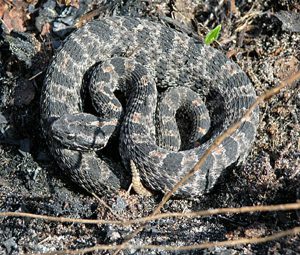 PYGMY RATTLESNAKE
PYGMY RATTLESNAKE 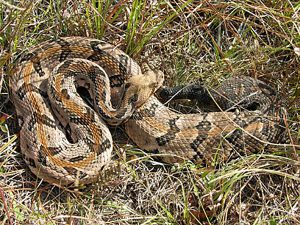 TIMBER RATTLERS
TIMBER RATTLERS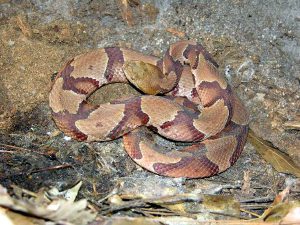 COPPERHEAD
COPPERHEAD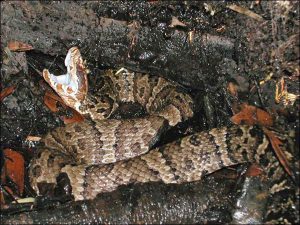 COTTONMOUTH or WATER MOCCASIN
COTTONMOUTH or WATER MOCCASIN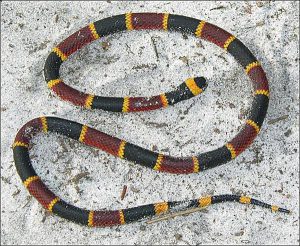 HARLEQUIN CORAL SNAKE
HARLEQUIN CORAL SNAKE
Comments:
February 10, 2022
Great learning and collaborative event, directed by Barbara Edmonds.
September 24, 2021
Great Blaire, spread the word and the mulch!
September 23, 2021
Great list and tips here on the gardening tools. I have definitely been a "volcano mulcher" in the past and learned my lesson. Definitely had some rot issues on a new tree I planted. I had no idea why the tree was struggling for about a year and then finally learned that I was the one hurting it... oh well. I've learned now haha.
May 28, 2021
My pleasure. You are welcome.
May 28, 2021
"Finally! I've been looking everywhere for a good list of home gardening tips blogs that won't straight out advertise their services....thank you for doing the effort of coalescing these. Thank you!"
April 12, 2021
Thanks so much! Will be calling.
April 9, 2021
Good afternoon, the next Master Gardener class is tentatively scheduled fall 2021. Online via ZOOM. Give me a call 352-486-5131 to discuss and reserve a spot for this fall. Thanks!
April 9, 2021
Hello Ms. Stewart, Yes the Levy County Extension office is located at 625 North Hathaway Avenue, Bronson, 32621. Hours Monday-Friday, 8-4:30 pm. Look forward to seeing you next week. Call 352-486-5131 for an appointment. Until then, "Feel Safe, Garden Happy"
April 9, 2021
Where is the Levy County Extension Office located? And is the Master Gardener located in Levy County or is she in Gainesville? I’d love to speak with her in person and bring some leaves from my rose bushes, so she can tell me what causes them to turn yellow when they’ve been watered faithfully.
March 4, 2021
Hi! When will the next master gardener program start up? And can I get the information for that one. So disappointed I missed the current one
December 14, 2020
Hello Gabby, It's good to hear from you! Look for the email with your name in subject line. The registration form will be attached. The 2021 course uses a combination of lecture recordings, live Q&A webinars, discussion forums and weekly activities to guide your learning. NEW! For 2021 - complete the course in the comfort of your own home with remote online class. I'll be facilitating with UF agents and specialists presenting topic material in video, lecture, text, audio and images. Multiple resources will help you build new knowledge. You'll be able to take an active role and be in charge of the learning process! Student handbook will be available for pickup or mailed, January 19. All my best, Barbara
December 14, 2020
Hello Gabby, It's good to hear from you! Look for the email with your name in subject line. The registration form will be attached. The 2021 course uses a combination of lecture recordings, live Q&A webinars, discussion forums and weekly activities to guide your learning. NEW! For 2021 - complete the course in the comfort of your own home with remote online class. I'll be facilitating with UF agents and specialists presenting topic material in video, lecture, text, audio and images. Multiple resources will help you build new knowledge. You'll be able to take an active role and be in charge of the learning process! Student handbook will be available for pickup or mailed, January 19. All my best, Barbara
December 11, 2020
Hello. I am interested in the Masters Gardeners course being offered. Thank
December 11, 2020
Hello. I am interested in the Masters Gardeners course being offered. Thank
December 8, 2020
Yes, thank you. That is another great option.
December 8, 2020
Best bet is to use a catcher on your mower if it's a push.
December 8, 2020
Hello Kathleen, Thank you for your interest in the 2021 Extension Master Gardener Volunteer program. I will email garden course registration information. In addition to expanding gardening skills we’ll dig deeper by understanding basic plant processes that affect plant growth, identify strategies to prevent and manage plant disease and understand origins and characteristics of Florida soils. I look forward to our gardening journey!
December 8, 2020
Hello Kathleen, Thank you for your interest in the 2021 Extension Master Gardener Volunteer program. I will email garden course registration information. In addition to expanding gardening skills we’ll dig deeper by understanding basic plant processes that affect plant growth, identify strategies to prevent and manage plant disease and understand origins and characteristics of Florida soils. I look forward to our gardening journey!
December 7, 2020
Good evening, I'm interested in registering for the Master Gardener Course starting in January. I looked into the course before the pandemic struck and I'm very excited you're offering it again. Please send any and all information related to the course including registration details. Thank you, Kathleen
December 7, 2020
Good evening, I'm interested in registering for the Master Gardener Course starting in January. I looked into the course before the pandemic struck and I'm very excited you're offering it again. Please send any and all information related to the course including registration details. Thank you, Kathleen
September 24, 2020
Useful information. Thanks for sharing.
August 7, 2020
I was on a dirt rd in Northern St Johns county a couple years ago. There was a good sized, thick snake in the road. I got out to get a better look, and couldnt identify the snake. It was obviously a pit viper, with the wide, triangular head. I grew up in N. florida , and have seen many snakes in the outdoor life I’ve lived. This one had me stumped. I thought maybe it was a canebreak rattler. But when I looked it up I found that it wasnt. To my suprise, the book had a picture that looked exactly like mine. It was a copperhead.!! The weird thing is that they aren’t supposed to be in this part of the state. But there he was.
June 11, 2020
My pleasure. Hope things are well with you and yours. Stay tuned for 'Colorful Containers' year round fun with plants and pots. Until next time - Spread Joy!
June 11, 2020
Thanks for a marvelous posting! I really enjoyed reading it,
October 31, 2019
Good afternoon Mr. Alden! Congrats on thinking several months in advance. To be most effective, pre-emergent should be applied once soils warm and conditions become favorable for seed to germinate. Therefore timing is crucial and varies from year to year in your area. Based on the species of existing warm season turf grass, the herbicide label will indicate what may be safely used on your warm season turf grass. In addition, the label will indicate when to apply and at what rate. Follow the label, the label is the law. For specifics, your local contact is Erin Harlow, Horticulture Agent, UF IFAS Extension Columbia County (eeeck@ufl.edu). Good luck with that!!
October 27, 2019
Whats the best preemergince herbicide for Fort White area of florida which is sandy?
March 11, 2019
Good afternoon Ms. Castles, I am sorry to hear about kitty and the sandspur conflict. It is a painful situation. Two items of interest; if you are in north Florida, you may consider applying a pre-emergent herbicide, suitable for your warm season turf grass in the next few weeks. Follow the product label and apply in the area where you know the burr have been seen. Once seed germinates, new leaves do resemble a grass-like plant to the undiscerning eye. This is an publication with sheath and hairs described. Click HERE. Dr. Laura Griffeth, UGA has a few images HERE. Lastly, from Florida A&M, several images HERE. Ms. Castles, I hope this is of help. Please feel free to call with any questions. Sincerely yours, Barbara
February 23, 2019
Could someone PLEASE provide a couple of pictures of sandspurs BEFORE they have spurs? I have searxyfor HOURS pleading for some visual reference to identify theses devilish weeds, but all I ever get are big pictures of tall weeds with many spurs, so obviously there’s no way to even pull them up by the roots when they are babies. Instead we have to wait until they are in full force. I suspect al these so called experts haven’t a clue either because they would have certainly provided a picture for the many requests. Even web search only provides pics of mature plants. Not even a verbal description.. Please prove me wrong ASAP. Grass is growing fast in fla and my cats paws are in awful shape thanks, Sally Castles
December 10, 2018
Good Morning Ms. Chancey, Thank you for choosing UF-Institute of Food and Agricultural Sciences (UF-IFAS) Extension, a trusted source of UF research based horticulture information. Yes, soil and air temperature play a key role in seed germination. As does soil moisture. Areas of Glynn County (Georgia) may experience micro-climates and greater potential for contamination of water bodies. In this situation, Glynn County Extension office would be the best source of herbicide application recommendations. Website: http://extension.uga.edu/county-offices/glynn.html Best of luck with sandspur control! Let me know how it goes.
December 9, 2018
Is there a known germination cycle based on temperatures? When is the best time in the life cycle to apply herbicide? Any ideas when sandspurs begin germination in South East GA near Brunswick? thanks, la
December 6, 2018
Good afternoon Mr. Slade, Thank you for choosing Levy County Extension as your trusted source of University of Florida researched based information. While I am not aware of a specific wholesale/retail nursery carrying the linebacker series, you may be able to source some online in addition to the following. I've been pleased with the Emerald Heights and Blue Cascade varieties, and look forward to winter flowering. Best of luck in your quest!
December 3, 2018
Barbara, Do you know the Florida growers that grow the distylium varieties, as well as sell to the public? I am looking for the Linebacker variety. Thanks, Jack
October 15, 2018
Hi Mrs. Vick, We've got good news! Your local extension office as part of the Cooperative Extension System (CES), established with the Smith-Lever Act of 1914, provides research-based education to the public to improve their daily lives. The CES represents partnerships between the USDA's National Institute of Food and Agriculture (NIFA) and land-grant universities, such as University of Florida, across the United States. The fine folks of Gonzales County Extension office are a great resource for control recommendations in your area. Wish you all the best with that!
October 13, 2018
We have a country property that we visit from time to time. When we visited more frequently, we were able to keep the sandspurs under some control in the immediate area of the house. This year we did not visit as often so now the sandspurs have taken over. The area we try to control is at least a couple of acres -- we have 15 acres so cannot control all. We had some success in the past by pulling and bagging the plants, but now they are so many that this would be very difficult to do. We would like to spread some sort of treatment now to kill off the plants. What would be the best way to do this so that we can get them under control again? We are Texas so the winters are quite mild.
October 11, 2018
Yes, it does make a spectacle of itself with yellow flowers and rose colored fruit capsules. University of Florida, Institute of Food and Agricultural Sciences IFAS) “Assessment of Non-native Plants in Florida’s Natural Areas” (https://assessment.ifas.ufl.edu/assessments/koelreuteria-elegans-subsp-formosana/, 2014) Gainesville, FL, 32611-4000, USA cautions use in Central and South Florida with re-assessment conducted every two years.
October 2, 2018
We have a beautiful Golden Rain tree that was planted in the trunk base of a fallen water oak tree in 2006. It has flourished with roots penetrating into the rotting tree mulch over the years. It now is very large, and is showy with lovely yellow blooms. A lovely addition to our landscape. And, with it's prolific nature, there are always plenty of young trees to dig up plant in pots and nurture, a nice gift to give away.
September 27, 2018
Hi James, May you enjoy many years of sandspur-free walks. Sounds like you are stepping in the right direction. Containing burr in an ever-diminishing area is a good idea. Easier to spot treat. Likewise, by mowing in clockwise pattern, blowing burr toward the center, will minimize spreading burr to uncontaminated areas. Wishing you good success!
September 26, 2018
Thank you. I've had pretty good success over the years pulling sandspur plants whenever I see them. I had a few get started in the lawn section of my five acre property and I'd forgotten about them due to my success of removing them as they seed in the fall. I recently committed to keeping an adjacent five acres mowed and was surprised my last mowing, late September, by several sandspur patches in full seed. I carefully mowed big circles around the patches and came back and removed the plants and seeds the best I could. This article gives me hope of having success. The last thing I want on my lot or the neighbors I maintain is sandspurs as I walk both properties morning and evening, mostly bare footed. I hadn't thought of dragging carpet or cloth to collect the seed pods. It's a great idea. I have been known to walk in my sock feet to collect seeds but carpet makes a lot more sense.
August 9, 2018
Hi BJ. An ocean view, framed by sea oats, sounds heavenly. I can see how a sandspur patch would diminish beach enjoyment. Unfortunately, a sandy lot is ideal for coastal sandbur. Lacking competition for available nutrients, water and light sandspur may spread unimpeded. However, its relatively shallow, fibrous roots will yield to digging or pulling. This is in your favor. Likewise, collecting burr this year means there will be fewer seed in the seed bank. All herbicides must be used in accordance with the label. Best of luck with controlling this sticky weed.
August 8, 2018
Do you recommend this treatment for sand? I don’t have a grass lawn; I live at the beach and have a sandy lot with sea oats, briars, and sand spurs.
July 23, 2018
That's a great idea. Thank you for the suggestion. I'll plan to incude pictures in future gardening blogs.
July 23, 2018
That's a great idea. Thank you for the suggestion. I'll plan to incude pictures in future gardening blogs.
July 21, 2018
You should have pictures of the weed, such as the air potato, you are talking about
July 21, 2018
You should have pictures of the weed, such as the air potato, you are talking about
June 21, 2018
Katie holds classes throughout the year. I will pass this information on to her and she will contact you. Sorry for the delay in response, but I've been on leave for six weeks.
June 21, 2018
I will pass on your email to Katie Trimm. She is hosting the class and she will contact you back.
June 20, 2018
I would like to register myself and my two sons for the cooking class
May 18, 2018
I would love to attend this but will be in England for the birth of my granddaughter. Will you be doing it again this year? Thank you!
April 22, 2018
Thank you so much for your information regarding sandspurs. We have a serious problem in our backyard that we are sure is a result of having a lawn company that "free cut" our lawn all last summer while we were traveling. I am a big fan of bagging my grass cutting to reduce the spread of weeds although I see the advantage of leaving cuttings on the ground when the lawn is healthy. We will shop for weed killers that contain the products you listed. Wish us luck !
December 7, 2017
thank you very much for all the info
December 6, 2017
Thank you - this was a helpful reminder!
December 4, 2017
I really enjoyed this post that you have describe here perfectly for Safe Venison from White-tailed Deer. thanks for this great idea
October 30, 2017
If anyone is interested in finding out more about the SHIP program in Levy County, contact Marlon Gayle at 352 486-5268. He is the coordinator for our county. His office is located in the Baker Building in Bronson. Thank you.
October 30, 2017
We would like to make the public aware of programs like SHIP and CDBG that offer assistance to home owners that need repairs done to their homes, and end up taking a turn for the worse. For going on 5 years now after applying to the SHIP program, qualify for assistance, 5 attempts later with engineers involved our septic system is now worse than it ever was before they stepped on our property. Not only SHIP but CDBG was involved in our home repairs, things took place in our home that you could not even imagine. We the home owners have been labeled demanding, not satisfied when indeed it was all shady work that was being done and all Levy County wanted to do is keep it quiet. So much wasted tax payers money, all because they would not listen to us the homeowners. Levy County has literally left us here again for the 5th time with a failed septic system. Everyone is aware and knows the system has failed again, but just walked away, said program ended, granted ended. Meanwhile septic is running not only into the street, our neighbors yards including the river where the county states they had permission to run a pipe into the river. All Levy County will state is program ended we have to fix it ourselves. They know we do not have the funds to fix it, if we did we would of never applied to this program, but just left us like this. How can a government, state program that is designed to help individuals like ourselves with repairs just walk away because they have not a clue how to address the issue? How can they allow people to come into your home through their program and destroy it and not care enough to listen to the homeowners when they are trying to report what is going on? How can this program still exists, be able to get more funding and continue on doing this to other homes. Are they not responsible to fix their errors? How can they make an homeowners home worse than it was before they entered their property? Their is so much wrong that went on here in our home and the one issue that we applied to the program for was our septic and that is the one thing they never fixed correctly but have made far worse than it ever was. Now Halloween is approaching us tomorrow and our whole front yard is full of holes this failed septic has created, trick or treats in the dark can not see these holes. Have contacted all involved more than once regarding this issue and none of them could care less. None of them will contact us back, last thing we want is to see someone fall and get hurt. We have a disabled child and we have had to deal with this on going issue going on 5 years. If we had the money to address this issue we would of never applied to a program for help, we did nothing wrong but asked for help. We have located a company that says they can address this issue and fix it correctly but again this program says grant closed, no more funds, but they still advertise for homeowners to apply and go on helping other families but leave us to sit here again with a stinking mess. How may we ask you can a government/state program be allowed to do this to someone's home and when they can not fix it just simply walk away and leave it far worse than it was?
August 2, 2017
Yes, we will host at least one Cloverbud camp. The exact details will be complete sometime early Spring. Genevieve A. Mendoza, 4-H Extension Agent
July 27, 2017
Will this camp be available next year?
June 21, 2017
Sounds like an awesome camp for the young people. I hope you let our elected officials know about this program and invite them to see the kids in the learn by doing activities. I would even contact the Governor since he vetoed 4-H. He needs to see the importance of this program. 4-H is not just a nice organization, but very necessary for our State's future leaders. All we can do as agents, volunteers, and parents is to educate the people who fund our organization. Keep up the great work!
Comments are closed.